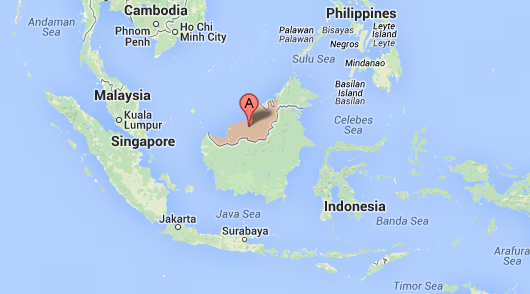From Earth Common Journal VOL. 3 NO. 1Who is King of Sarawak's Rainforest? An Insight to Sarawak's Land Corruption Led by its Chief Minister and His Family
IN THIS ARTICLE
KEYWORDS
AbstractMalaysia's 13th General Elections were hopes of many to be the turning point of change, breaking Barisan Nasional's (BN or National Front) 56 years of governance. BN in recent years had been plagued with allegations of corruption and cronyism. Land grabs in the state of Sarawak, exposed an intricate and systematic corruption that happens in all levels of government in Malaysia. The perils of the rainforest in Sarawak are uncovered through a corrupt systematic mass deforestation through the governance of its Chief Minister Taib Mahmud. Was Malaysia's latest election successful in dethroning Taib and his family out of their political powers? Taib holding several portfolios puts him in immense political and economic power. For more than 30 years, Taib has made use of his various ministerial roles to methodically harvest the state's natural resources and amassing a personal fortune of USD $15 billion. The first family of Sarawak too has their share in Taib's fortunes. Kickbacks, corrupt land deals, evasion of Malaysian tax and the service economy of corruption were true and evident in the family's dealings. Taib's eldest daughter, Jamilah Taib and her husband Sean Murray, well known socialites in Ottawa, Canada play a major role in the slow death of Sarawak's rainforest and indigenous tribes. One woman, Clare Rewcastle Brown who manages Sarawak Report and Radio Free Sarawak is determined to bring down the supreme rule of Taib and his family. Her media outlets aim "… to provide that platform and to offer an alternative vision of justice, transparency and a fairer future in Sarawak." Malaysia's Political ShakeupsThe 12th general elections in Malaysia witnessed one of its biggest political shakeups in history. "After a 13 day campaign with a 70 percent voter turnout, the outcome was shocking, …" (Marck, as cited in Singh, 2009, p. 157). So shocking, " "Political tsunami" is how theSunday Star summed things up" (The Economist, 2008, para. 1). The term 'political tsunami' gained notoriety among the Malaysian national press, local social media forums and the world over. Despite winning 140 of the 222 seats in the federal parliament, the coalition party Barisan Nasional (BN or National Front) yielded one of the worst results since gaining independence in 1957 (The Economist, 2008, para. 2). The severity of this loss was reflected when "…the stockmarket fell by 10 percent on Monday as investors worried about the danger of unrest and instability" (The Economist, 2008, para. 2). The significant loss can be reflected in numbers, in 2004 BN won 64 percent of the votes and 90 percent of the parliamentary seats however, in 2008 it won only 51 percent of the votes and 63 percent of parliamentary seats; losing two thirds supermajority (The Economist, 2008, para. 3-4). Singh (2009, p. 163) pointed out that one of the major reasons for BN's alarming loss was due to the voters being angered by the rampant corruption and abuse of power. Former Prime Minister Abdullah Ahmad Badawi took a stance "…to clean up the system under his National Intergrity Plan (Singh, 2009, p. 159) and set up an independent Anti-Corruption Agency (ACA)" (Balfour, as cited by Singh, 2009, p. 159). However, his struggles to remain in power and keeping true to his word: "…personal weakness and lack of conviction saw corruption reforms go downhill" (Singh, 2009, p. 159). Singh (2009, p. 159) noted that in 2007, numerous scandals implicating senior officials in the government, police and judiciary came to light. The year 2013 marked an unprecedented election fever, power play and mass use of social media. As soon as Prime Minister Najib Razak called for the 13th general elections to take place on May 5; Malaysians were up in a frenzy craving for a new reformation on various political, economical and social issues breaking BN's iron grip. The surprising performance of BN's opposition, Pakatan Rakyat (PKR or People's Alliance) in the last general elections "added new energy to Malaysian politics and powerful voice critical of the incumbent (Nehru & Tran, 2013, para. 4). In the last general elections, Nehru and Tran (2013, para. 12) acknowledged that PR won nearly half the popular votes (47%), but it took just over a third (37%) of the parliamentary seats. Polls indicated that despite Prime Minister Najib Razak's approval rating remained above 60 percent, Nehru and Tran (2013, para. 6) stated the BN coalition was not favoured with an approval rating of only 45 percent. Again, it was no secret; BN had been flooded with many allegations of corruption and cronyism. Nehru and Tran (2013, para. 6) highlighted the issue of land grabs (massive deforestation) in the state of Sarawak, exposing an intricate and systematic corruption that happens in all levels of government in Malaysia. About SarawakSarawak is located in the east of the South China Sea and is the largest of Malaysia's 13 states. It is one of the two Malaysian states located on the third largest island in the world – Borneo (Sarawak Government, About, 2013). Popularly known as the Land of the Hornbills, Sarawak is surrounded by the sultanate of Brunei and Sabah (Malaysia) on the north and by Indonesia Borneo (Kalimantan) on the east and south (Encyclopedia Britannica, 2013). Located immediately north of the equator, Sarawak stretches some 800 kilometres along the northwest coast of Borneo and covers an area of 124,449.51 square kilometers (Sarawak Government, 2013).
According to the latest Population and Housing Census in 2010, Sarawak has an estimated population of over 2.4 million with an annual population growth rate of 1.8 percent (Sarawak Government, The Demographics of Sarawak, 2013). Sarawak is a multicultural state made up of 27 ethnic groups (Sarawak Government, The Demographics of Sarawak, 2013) and other sub-ethnic groups. According to Wonderful Malaysia (2013, para. 7) the three largest ethnic groups-Iban, Bidayuh and Orang Ulu are collectively known as the Dayaks, which means upstream or inland. It is common for these groups to live in longhouses, traditional community homes that are capable of housing 20 to 100 families often times tucked away in the lush tropical rainforest (Wonderful Malaysia, 2013, para. 7). Sarawak's topography is divided into three regions-coastal lowlands compromising peat swamps as well as narrow deltaic and alluvial plains; a wide are of undulating hills and a mountainous highlands extending to the Kalimantan border (Sarawak Government, The Geography of Sarawak, 2013). With an equatorial climate, humidity is consistently high in the lowlands raging from 80 to 90 percent whereas the temperature in Sarawak ranges from 23 degress Celcius early morning to 32 degrees Celcius during the day (Sarawak Government, The Geography of Sarawak, 2013). The highlands have cooler temperatures. Bario's temperatures hovers between 16 to 25 degrees Celcius during the day and gets as low as 11 degrees Celcius on some nights (Sarawak Government, The Geography of Sarawak, 2013). According to the Sarawak Government (The Geography of Sarawak, 2013), the average rainfall per year is between 3,300 millimetres and 4,600 millimetres depending on the region. Sarawak's main economic drive is its heavy reliance on the abundance of the state's natural resources. The economic structure of Sarawak is largely export oriented, primary commodities such as timber, oil and natural gas including palm oil (forestry, mining and agriculture) dominating the economy. "In 2011, industries involved in the extraction and processing of these commodities contribute about 50% towards the state's output" (State Planning Unit, Economy, 2013). Lately, the exportation of palm oil is an emerging business for Sarawak and all efforts have been taken to ensure Sarawak's competitive advantage in this economically significant segment of the primary sector. A report from the State Planning Unit of Sarawak (Economy, 2013) reported that in 2011, the production of crude palm oil went beyond 2 million tones, exported primarily to China and India. Perils of Sarawak's RainforestBorneo is well known among nature lovers, world travelers and environmentalists to be one of the world's most distinct and species rich. The Sarawak Government (The Geography of Sarawak, 2013) reports about "…80 percent or 10 million hectares of Sarawak's total land area is covered with forest (natural as well as secondary forests)." The remainder 20 percent (2.3 million hectares) is under settlements, towns, agricultural crop cultivation and native customary rights (Sarawak Government, The Geography of Sarawak, 2013). According to the Department Forest of Sarawak (as cited by Bruno Manser Fund, 2012, p.4) flora in Sarawak includes approximately 8,000 species of vascular plants, 2,000 tree species, 1,000 orchids, 757 ferns and 260 species of palm. "Fauna in Sarawak includes roughly 185 species of mammal, 530 species of bird, 186 species of snake, 104 species of lizard and 113 species of amphibian" (Department Forest of Sarawak, as cited by Bruno Manser Fund, 2012, p. 4). The United Nations (UN) in 2000 awarded Gunung Mulu National Park, Sarawak's largest national park with a UNESCO World Heritage Site (Sarawak Tourism, Gunung Mulu National Park, 2011). This heritage site is important both for its high biodiversity and karst features making it the world's most studied tropical karst area in the world (Sarawak Government, The Geography of Sarawak, 2013). Some of the other accolades Gunun Mulu has received are the world's largest natural chamber, the world's largest cave passage and the longest cave in South East Asia (Sarawak Tourism, Gunung Mulu National Park, 2011). In September 2011, a freelance reporter Jeswan Kaur criticized the UN through its Millenium Development Goals (MDGs) 2010 report for praising the state of Sarawak on a "job well done" in addressing issues of human rights abuse and environmental damage (Kaur, 2011, para. 1). Kaur claimed that under the corrupt leadership of Chief Minister Taib Mahmud, he has refused to promote gender equality and empower women, "… as seen from the never-ending rapes of the Penan women and girls by timber loggers" (Kaur, 2011, para. 7). She further argued that under the leadership of Taib, continous logging activities have disrupted the lives of the natives, with loggers boldly encroaching native lands, which have been snatched for logging, mining and plantation purposes. Kaur (2011, para. 19) reported that it was a stark contrast to the Malaysian 2008 annual auditor-general's report that deemed the state government of Sarawak's forest management was unsatisfactory. Despite Chief Minister Taib's claims that 70 percent of Sarawak's rainforest is still intact while 14 percent of its "secondary forests" have been replanted or are in the process of being converted to plantations, Butler (2011, para. 1) reported that satellite images from Google Earth showed a stark contrast between forest cover in Sarawak and its Borneo neighbours. Butler (2011, para. 3) further affirmed that the images appear to support claims from environmentalists with some groups estimating Sarawak has experienced a loss of 90 percent of its primary forest cover. Forests that remain have been selectively but heavily logged approximately two or three times over in the past 30 years according to Butler (2011, para. 3). He added these forest areas have been converted for timber, wood-pulp and timber plantations. In June 2013, Sukumaran a reporter for The Star Online, published an article stating that Malaysia saw an increase of 115 percent in deforestation during the first three months of 2013 (2013, para. 1). This report was made according "… to a forest tracking tool developed by National Aeronautics and Space Administration (NASA) researchers" (Sukumaran, 2013, para. 1). Sukumaran (2013, para 2) further reported that Malaysia led the way by being the top country where deforestation was rampant followed by Nepal (114%), Mexico (92%), Argentina (72%) and Madagascar (51%). In an interview, Christopher Potter, a senior research scientist at NASA Ames Research Centre told Sukumaran (2013, para 4) that numerous areas in Sarawak have been detected with forest cover change over the past two years. Britain's former Prime Minister in 2011, condemned the destruction of Sarawak's rainforest stating is, "probably the biggest environmental crime of our times…Malaysia's once vast pristine jungle has been stripped bare and enormous areas have been planted with oil palm in an environmental nightmare that shows no sign of slowing" (Brown, as cited by Bruno Manser Fund, 2012, p. 4). Kaur (2011, para. 9) blamed Taib's increasing greed is the man responsible for the rapid balding of Sarawak's rainforest, no thanks to the continuous logging carried out by his cronies.Continued on Next Page » Suggested Reading from Inquiries Journal
Inquiries Journal provides undergraduate and graduate students around the world a platform for the wide dissemination of academic work over a range of core disciplines. Representing the work of students from hundreds of institutions around the globe, Inquiries Journal's large database of academic articles is completely free. Learn more | Blog | Submit Latest in Political Science |




















